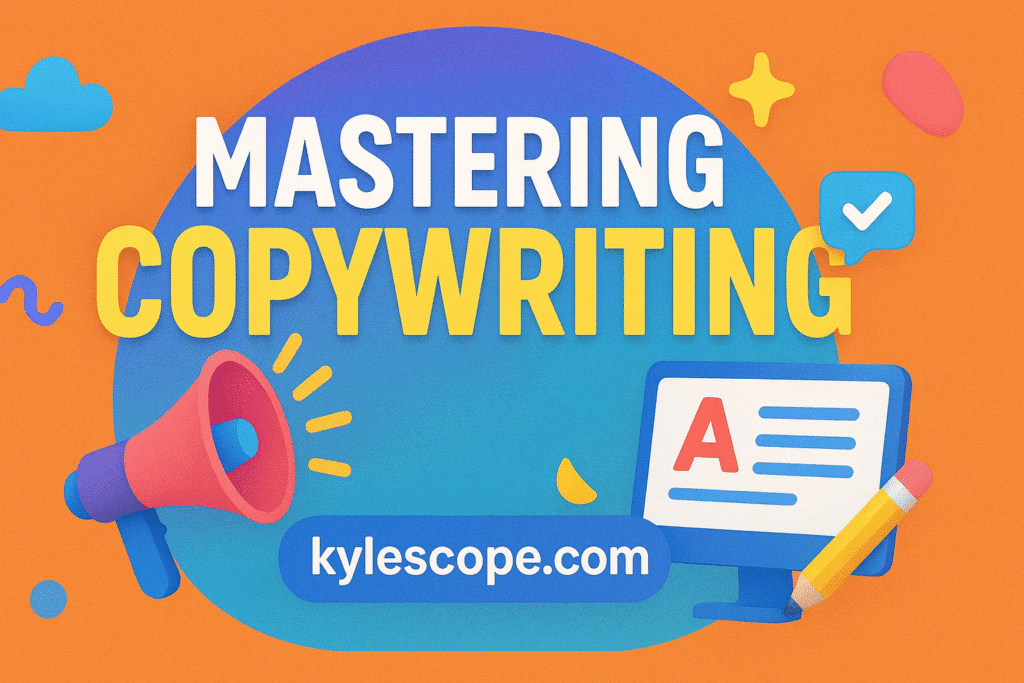
Introduction
Copywriting is the strategic art of using words to drive action. From landing pages to product descriptions, it transforms passive readers into active customers. It is not simply about writing; it is about structuring language in a way that compels, persuades, and motivates. Every sentence has a purpose, and every element of text works together to guide the reader toward a decision. This guide draws exclusively from Copywriting 101: How to Craft Compelling Copy by Copyblogger, ensuring that the insights remain grounded in proven principles.
In this long-form instructional article, you will learn the fundamentals of persuasive writing, the frameworks that guide effective messaging, and the services available to support businesses in their communication strategies. Each section builds upon the last, creating a structured roadmap for anyone who wants to understand how words can shape behavior in digital spaces.
What Is Copywriting?
Definition, Purpose, and Scope
Copywriting is the practice of strategically delivering words that inspire action. It is not limited to advertisements but extends to blog posts, emails, tutorials, and even social media captions. The purpose is always the same: to get the first sentence read, then the next, and eventually lead the reader toward a decision. Legendary marketer Joe Sugarman emphasized that every element of text serves one purpose: to move the reader forward, sentence by sentence, until they reach the offer.
The scope of this discipline is vast. It covers headlines that capture attention, body text that builds trust, and calls to action that close the loop. It is both an art and a science, requiring creativity and a structured approach. To explore the foundational concept of persuasive text, you can review What Is Copy?, which provides a deeper look into how words function as tools of influence.
Why Clarity Matters
Clarity defines effective writing. Shakespeare’s famous line “To be, or not to be” demonstrates how simple words can carry immense weight. Complex phrasing can alienate readers, while straightforward language fosters connection. Studies show that even educated audiences prefer clear, concise communication. Therefore, the best copy avoids unnecessary jargon and focuses on accessibility.
Writers must also remember that simplicity does not mean dullness. Instead, it means crafting sentences that flow naturally and resonate with the reader’s emotions. By focusing on clarity, writers ensure that their message reaches the widest possible audience without sacrificing depth.
Why Copywriting Matters in Digital Strategy
SEO, Branding, and Conversion Optimization
In digital marketing, persuasive writing is the backbone of visibility and engagement. Search engines reward content that aligns with user intent, making keyword integration a crucial aspect. However, optimization alone is not enough. The text must also reflect brand identity and encourage conversions. A headline that ranks well but fails to attract clicks has no value.
Branding relies on consistent messaging. Every sentence reinforces the values and promises of a business. When readers encounter a brand voice that feels authentic, they are more likely to trust the offer. Conversion optimization then closes the loop by guiding readers toward specific actions, such as subscribing, making a purchase, or sharing content.
The Role of Headlines in Strategy
Headlines determine whether content gets read. According to Copyblogger, eight out of ten people read headlines, but only two out of ten continue to the body. This statistic highlights the importance of crafting titles that promise value. Techniques such as the “Four U’s” (valuable, urgent, unique, ultra-specific) provide a framework for creating compelling headlines.
David Ogilvy, a pioneer in advertising, rewrote a single headline over one hundred times to achieve perfection. His dedication illustrates the significant impact a headline can have on determining success. Without a strong opening, even the most valuable content risks being ignored.
Types of Copywriting
Sales Copy, Email Copy, UX Copy, and Ad Copy
Different contexts require different approaches. Sales copy focuses on persuasion, often using long-form structures to address objections and highlight benefits. Email copy emphasizes brevity and personalization, guiding readers toward clicks and conversions. UX copy, frequently overlooked, ensures that digital interfaces communicate clearly and guide users seamlessly. Ad copy, on the other hand, condenses persuasion into a few powerful words.
Each type requires a unique balance of creativity and structure. Sales pages may rely on storytelling, while UX text must prioritize clarity. Email campaigns often employ conversational tones, whereas advertisements require precision. To explore professional support in these areas, consider reviewing Hire a Copywriter, which outlines how experts tailor their skills to different formats.
The Importance of Adaptability
Adaptability separates average writers from professionals. A skilled practitioner can transition seamlessly from a technical product description to a playful social media post without compromising effectiveness. This flexibility ensures that messaging remains consistent across platforms while adapting to audience expectations.
For example, a product launch email may highlight urgency, while a landing page emphasizes benefits. Both pieces serve the same campaign but require different tones. By mastering multiple formats, writers ensure that their words resonate in every context.
Copywriting vs. Content Writing
Clarifying Roles and Outcomes
Although often confused, copywriting and content writing serve different purposes. Content writing informs, educates, or entertains, while copywriting persuades. A blog post may explain industry trends, but a sales page must convince readers to take action. Both are essential, but they serve distinct purposes.
The outcomes also differ. Content writing builds long-term trust and authority, while persuasive writing drives immediate results. Businesses that integrate both approaches create a balanced strategy that nurtures audiences while generating conversions.
Why the Distinction Matters
Understanding the distinction prevents misaligned expectations. A company that hires a content writer to produce persuasive sales pages may feel disappointed, while a copywriter tasked with producing thought leadership articles may struggle. Recognizing the unique strengths of each role ensures that projects align with the right expertise.
This clarity also helps businesses allocate resources effectively. By distinguishing between education and persuasion, organizations can design campaigns that meet both short-term and long-term goals.
How to Write Copy That Converts
Frameworks: AIDA, PAS, and FAB
Effective persuasion often follows structured frameworks. The AIDA model (Attention, Interest, Desire, Action) guides readers through a logical sequence of steps. PAS (Problem, Agitation, Solution) highlights pain points before offering relief. FAB (Features, Advantages, Benefits) connects product details to emotional outcomes.
Each framework provides a roadmap for structuring text. For example, a landing page may begin with a bold headline (attention), explain the problem (interest), highlight the solution (desire), and end with a clear call to action (action). These frameworks ensure that writing remains focused and persuasive.
CTA Design, Tone, and Audience Targeting
Calls to action (CTAs) determine whether readers take the final step. A strong CTA utilizes active verbs, explicit promises, and a sense of urgency. Phrases like “Start your free trial today” or “Download your guide now” outperform vague prompts.
Tone also matters. A playful brand may use humor, while a financial institution must project authority. Audience targeting ensures that the message resonates with the right demographic. By combining strong CTAs with tailored tone, writers maximize conversions.
Copywriting Services: What to Expect
Process, Deliverables, and Pricing Models
Professional services provide structured processes that ensure quality. Clients can expect research, drafts, revisions, and final deliverables tailored to their goals. Deliverables may include sales pages, email sequences, or social media campaigns. Pricing models vary, ranging from project-based fees to retainers.
Transparency defines professional services. Clear timelines, defined deliverables, and measurable outcomes build trust between clients and providers. Businesses that invest in expert support often see higher returns on their marketing efforts.
Finding the Right Partner
Choosing the right partner requires evaluating expertise, portfolio, and alignment with brand values. A skilled provider not only delivers text but also offers strategic guidance. To explore professional options, review Copywriting Services, which outlines processes and expectations for businesses seeking expert support.
Investing in professional services ensures that messaging remains consistent, persuasive, and aligned with business goals. It also frees internal teams to focus on other priorities while experts handle the communication strategy.
Practical Lessons from Persuasive Writing
The Power of Simplicity
Complexity alienates readers. Simple, direct language ensures that messages resonate with a wide range of demographics. Even highly educated audiences prefer clarity over jargon. Writers who prioritize simplicity build stronger connections and achieve higher engagement.
The Role of Proof and Guarantees
Promises alone do not persuade. Readers demand proof in the form of testimonials, statistics, or guarantees. For example, Domino’s Pizza built its reputation on the promise of delivering meals within thirty minutes or the meal would be free. Such guarantees reduce risk and increase trust.
Conclusion: Taking Action with Copywriting Services
Persuasive writing is more than a marketing tool; it is the foundation of digital communication. From headlines to CTAs, every element works together to guide readers toward action. By mastering frameworks, distinguishing between roles, and investing in professional services, businesses can transform their communication strategies.
If you want to elevate your messaging and achieve measurable results, consider exploring expert copywriting services. Professional support ensures that your words not only inform but also inspire action. For additional insights into persuasive writing, you can also explore resources such as Neil Patel’s guide to copywriting, which complements the principles outlined here
